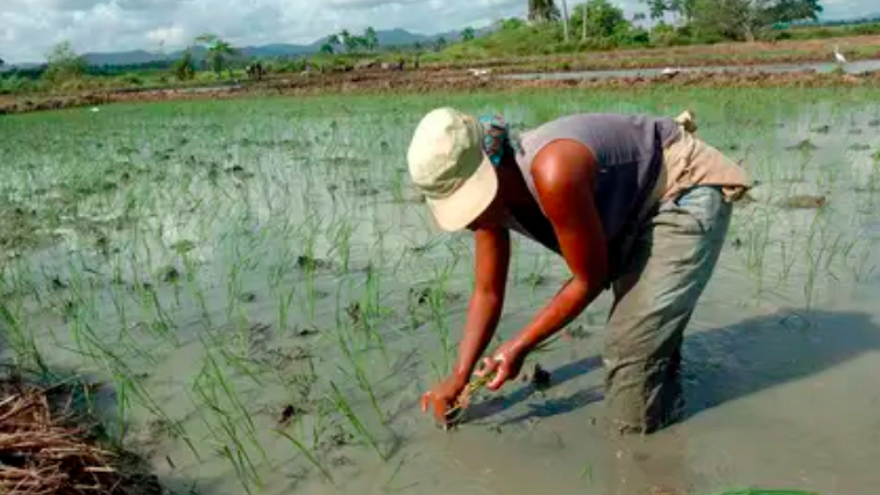
![]() 14ymedio, Mercedes García, Sancti Spíritus, August 17, 2023 — With the lack of rain, the departure of Vietnamese technicians and, now, a new state regulation that will limit the amount assigned for producers’ consumption, the rice-growing region of La Sierpe, in Sancti Spíritus, is living through difficult times. This norm, which has not yet gone into effect, is part of a new package of measures to prevent the cereal from ending up on the black market while the country is suffering a profound food crisis.
14ymedio, Mercedes García, Sancti Spíritus, August 17, 2023 — With the lack of rain, the departure of Vietnamese technicians and, now, a new state regulation that will limit the amount assigned for producers’ consumption, the rice-growing region of La Sierpe, in Sancti Spíritus, is living through difficult times. This norm, which has not yet gone into effect, is part of a new package of measures to prevent the cereal from ending up on the black market while the country is suffering a profound food crisis.
Actually, most farmers who grow rice in La Sierpe use state lands — leased to them under usufruct — hence must abide by any norms of the Ministry of Agriculture and other official entities. Disobeying any regulation of this kind could cost them their use of the land and the loss of what they have already invested in those lots.
“How can they know if the rice we separate for ourselves is enough or too much for our own consumption?” asked Daniel, one of the producers who will be affected by the new measure, which is being prepared to be applied in the coming months. “They say we are selling it on the black market but it’s that in my house, for example, each time there is less to put on the plate and rice is what we have left.”
Several officials from the area have visited the farmers to warn them of the new norm, although they have not talked about quantities for the moment. “They have come house to house and say the machete will come down in the coming months. They say that next year we will need to adjust to a smaller quantity,” explained Daniel to 14ymedio.
Authorities have warned that they will base their calculations on the number of people in the producer’s family and whether they have other crops such as root vegetables, fruits or vegetables that could complete the household food supply. They will also take into account whether the rice producer has met the cereal production targets and whether there have been previous complaints that they have diverted part of the harvest to the informal market. The formula for arriving at the total number of sacks each farmer can keep is not simple and raises suspicion.
Producers believe that the motivation for this reduction is “the low production and that people are very unsatisfied with the price of rice in the markets. Of course, now they want to punish the same people as always because the rope breaks where it is thinnest,” says Daniel. “What is going to happen with this is that farmers will leave, in the same way that the Vietnamese left.”
In 2022 a rice project began in La Sierpe in collaboration with Vietnam, which supplied equipment and machinery to producers in several regions of the Island, with the support of dozens of specialists and technicians. They bet mainly on the plains of Sancti Spíritus in this collaboration and there they made dikes, cleared canals and trained local specialists.
However, after a few years during which cereal production increased significantly, the yields of rice fields took a nose dive and was unable to meet the expectations of the Vietnamese, who also had to deal with the convoluted state bureaucracy and the inefficiency of Empresa Agroindustrial. The final blow to the project was the current fuel crisis.
“Here, most rice producers are new generation usufructuaries and a few are cooperative members,” an administrative employee of the company explained to us. “They are the ones who took the land when the Vietnamese left and the state wanted to increase production. They were fields that had been worked for this crop, which is hard and difficult, and also very dependent on rains and irrigation,” said the employee.
“Everyone knows that if producers do not have extra earnings selling some of the rice they declare as being for their own consumption, very few people would want to work in these fields because it is a lot of effort every day for the low price the state pays for each sack,” said the woman.
After the departure of the Vietnamese, the area’s productivity has gone off a cliff. If in 2015 they managed to produce up to five tons of cereal per hectare, in 2023 they barely get three. In the agricultural markets of Sancti Spíritus this week one pound of rice sells for 160 pesos and the product leaves a lot to be desired among clients due to the high proportion of split grains.
Now, with the announcement of the upcoming measure many are thinking, “pack up everything and leave the crops half way,” said Daniel. Either way, he has let his close family and friends know to purchase and store rice. “It could reach 200 pesos or more per pound before the end of the year,” he predicts.
Translated by: Silvia Suárez
____________
COLLABORATE WITH OUR WORK: The 14ymedio team is committed to practicing serious journalism that reflects Cuba’s reality in all its depth. Thank you for joining us on this long journey. We invite you to continue supporting us by becoming a member of 14ymedio now. Together we can continue transforming journalism in Cuba.
